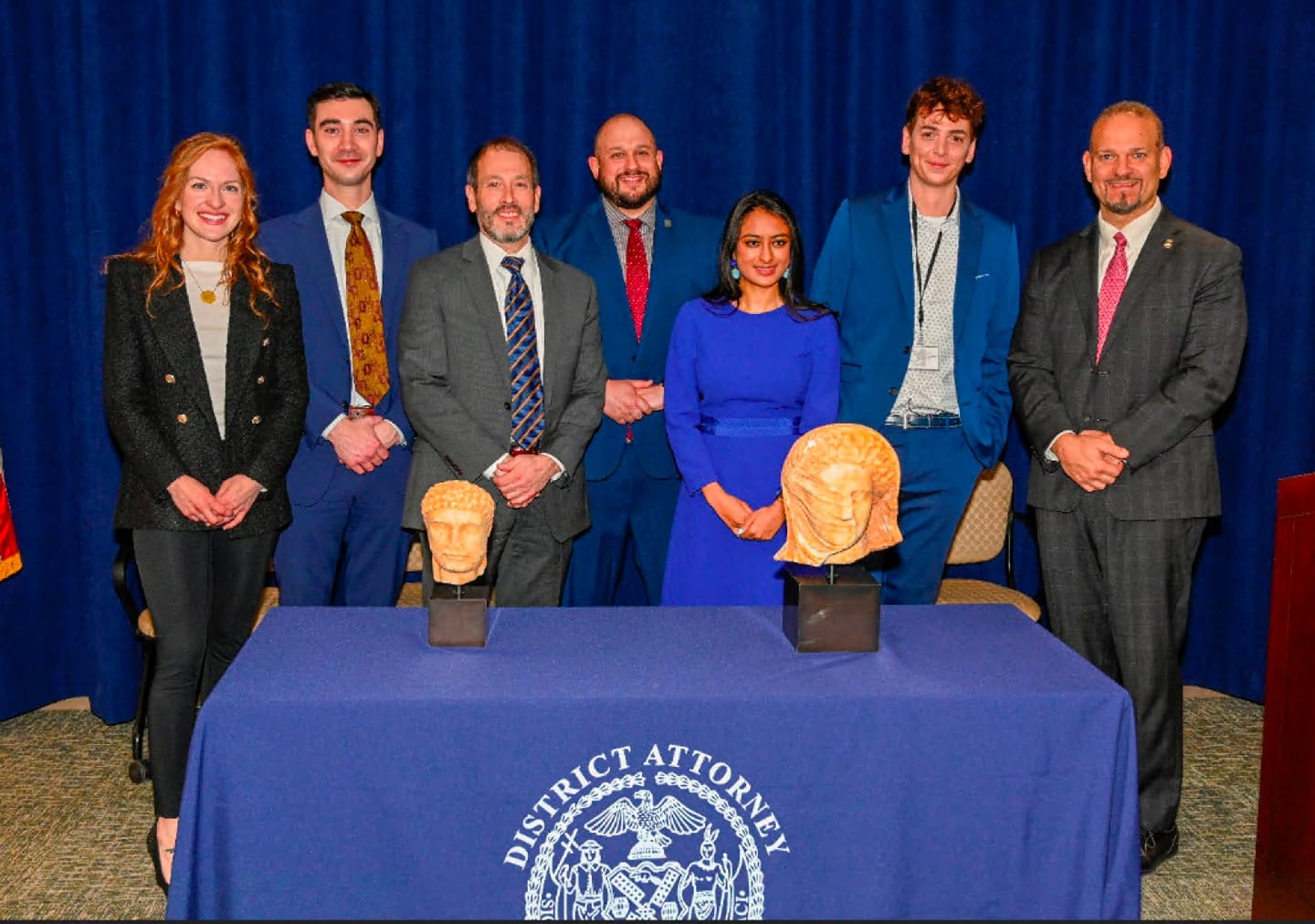 Aboutaams,Christos Tsirogiannis,Edward Merrin,Guennol Stargazer,Harmon Fine Arts,Leonard Norman Stern,Michael Steinhardt,Moshe Bronstein,Robert Haber,Samuel Merrin,Shlomo Moussaieff,William Veres
Aboutaams,Christos Tsirogiannis,Edward Merrin,Guennol Stargazer,Harmon Fine Arts,Leonard Norman Stern,Michael Steinhardt,Moshe Bronstein,Robert Haber,Samuel Merrin,Shlomo Moussaieff,William Veres
 No comments
No comments
More on the Manhattan billionaire Michael Steinhardt's whose private collection now faces further seizures
Steinhardt is a member of Christie’s advisory board. He also has a Greek Art of the Sixth Century B.C. gallery named after him at the Metropolitan Museum of Art in New York. All this to say that he should be sufficiently well informed about the ethical obligations of responsibly acquiring, managing and disposing of items in his burgeoning art collection. When not sufficiently informed, his position of affluence and philanthropic influence affords him the ability to reach out to knowledgable art world connections, who could advise him of the regulatory structures in place and the moral economy of purchasing and collecting illicit antiquities should he have any doubts.
On Friday, January 5, 2018, Manhattan district attorney, Cyrus R. Vance Jr., and assistant district attorney Matthew Bogdanos again initiated custody of ten antiquities, prosecutors state were looted from the countries of Greece and Italy.
Purchased in the last twelve years, the ten objects seized in last week's raid are listed as:
A) Greek Attic Monumental White-Ground Lekythos (the “White-Ground Lekythos”), used to pour ritual oils at funeral ceremonies. Vessel attributed to the Triglyph Painter and depicts funerary related iconography featuring a woman and a youth.
Period: approximately 420 BCE.
Measurement: 18 inches tall by 4.5 inches wide.
Purchased for $380,000 in 2006.
B) Apulian Rhyton for libations (the “Apulian African Head Flask”) in the shape of the head of an African.
Period: dating to the 4th century BCE
Measurement: 7.5 inches tall by 3 inches at base.
Purchased for $130,000 in 2009.
C) Italo - Corinthian pottery figural representing a duck with its head turned upwards (the “Italo-Corinthian Duck”). This style of Greek perfume holder flourished at Corinth during the Oriental period
Period: dating to the 6th century BCE
Measurement: 4 inches tall by 5.5 inches long by 2.5 wide.
Purchased for $25,000 in 2011.
D) Ionian sculpture figural representing a ram’s head (the “Ionian Ram’s Head”).
Period: dating to the 6th century BCE
Measurement: 2.5 inches tall by 4.7 wide.
Purchased for $70,000 in 2009.
E) Attic Aryballos in the form of a Head of an African (the “Attic African Head Aryballos”).
Period: dating to the 5th century BCE
Measurement: 4 inches tall.
Purchased for $150,000 on or about December 17, 2009.
F) Corinthian terracotta figural vessel representing a lion (the “Corinthian Lion Vessel”). This style of Greek perfume holder flourished at Corinth during the Oriental period
Period: dating to 600-550 BCE
Measurement: 3.5 wide.
Purchased for $25,000 on or about November 9, 2011.
G) Proto - Corinthian pottery figural representing an owl (the “Proto-Corinthian Owl”). This style of Greek perfume holder flourished at Corinth during the Oriental period
Period: dating to 650-625 BCE
Measurement: 2 inches tall by 2.2 wide.
Purchased for $120,000 on or about October 14, 2009.
H) Proto - Corinthian pottery figural representing a duck with its head turned backwards (the “Proto-Corinthian Duck”). This style of Greek perfume holder flourished at Corinth during the Oriental period
Period: dating to 650-625 BCE
Measurement: 2 inches tall by 2.7 wide.
Purchased for $130,000 on or about October 14, 2009.
I) Corinthian BUll’s Head (the “Corinthian Bull’s Head”).
Period: dating to 580 BCE
Measurement: 2.2 inches tall by 2.8 wide.
Purchased for $60,000 on or about October 14, 2009.
j) Bronze Handles (the “Bronze Handles”).
Period: unknown
Measurement: 3.6 inches tall by 9.4 wide.
Purchased for $40,000 in 1996.
Some of Steinhardt's previous risky antiquities gambles:
Sidon Marble Head of a Bull (ca 500-460 BCE)
and
a 6th century marble torso of a calf bearer
 |
| Marble Head of a Bull (ca 500-460 BCE) and a 6th century BCE marble torso of a calf bearer. |
Just last month the US repatriated two Eshamun Sculptures seized from Steinhardt's private collection. Both pieces found their way onto the international antiquities black market after being stolen during Lebanon's tumultuous civil war. Before their theft, both antiquities had been excavated at the Temple of Eshmun in 1967 near Sidon in southwestern Lebanon.
The Beierwaltes in turn relinquished all ownership claims when the illicit provenance of the objects was solidly made clear.
NOTE: The Beierwaltes were long-term clients of Robin Symes and Christos Michaelides at the time of these purchases.
An Anatolian marble female idol of Kiliya type, AKA The Guennol Stargazer
 |
| Screenshot from “The Exceptional Sale,” April 2017 Image Credit: Christie’s New York |
During that time period, the purchaser’s hammer price + buyer's premium bid of $14,471,500 USD was confirmed but not collected. As a result of the object being contested, the would-be buyer bowed out from the purchase, shortly after the case began being discussed in the international press.
Christie's and Steinhardt issued a motion to quash Turkey's lawsuit. While the case has not been resolved, ultimately Turkey's fight for repatriation may hinge on two critical points: whether the country can conclusively show that the piece in question was discovered in Turkey, and whether the nation laid claim to the artifact in a timely fashion, given the length of time Steinhardt had the object in his collection.
A Sardinian Marble Female Idol of the Ozieri Culture
United States v. One Triangular Fresco Fragment
Despite the object's obvious Italian origin, the shipment had a customs declaration form which falsified the object's country of origin as Macedonia. The fragment was forfeited to the U.S. government and repatriated to Italy on February 24, 2015.



































